Rocket Riot - Review
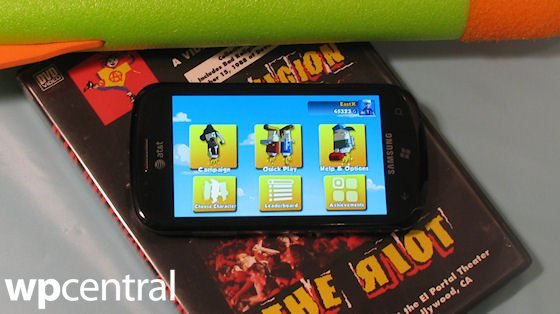
Among Windows Phone 7’s most unique features is the Xbox Live service. The mobile versions of many Xbox 360 console games can find their way exclusively to Windows Phone 7. One such game, ilomilo (review), actually debuted first on Windows Phone 7 before hitting the Xbox 360’s Xbox Live Arcade service a few months later. Rocket Riot, from developer Code Glue, took the other way around: it’s come to Microsoft’s mobile phone platform over a year after releasing as a downloadable console title.
Rocket Riot is a twin-stick, side view shooter (without the physical sticks). This means players control their character’s movement and firing direction independently. Does this control method work well on the touch-screen, without the presence of sticks? Fly past the break to find out.
Is that a rocket in your pocket?
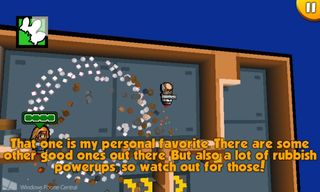
Rocket Riot earns its name in two ways: characters fly around using rockets, and they shoot at each other with rocket launchers. You can fly around as much as you like by swiping and holding in any direction on the left side of the screen; keep your finger away for a moment to hover and eventually sink back to the ground. The right side of the screen controls firing. Short swipes shoot rapidly while long swipes have longer trajectories. Here the mobile version of Rocket Riot actually trumps the Xbox 360 original. On the console, tapping the right stick rapidly wouldn’t fire rockets nearly far enough; they tended to peter out much too close to the player. It’s much easier to shoot decently far on WP7. In short, this port of Rocket Riot controls exceptionally well.
Victory usually comes from destroying all of the enemies in a stage without dying. You can’t block, so dodging, hiding behind things, and tunneling become extremely important. Yes, I said tunneling. Unlike most shooters, environments are fully destructible, so players can create their own shortcuts and escape routes by blasting at the ground and other objects. Firepower can be just as important as dodging, though. Rocket Riot’s power ups range from standard items like 3-way fire (incredibly useful) and homing rockets to the bizarre, like a shield made of spinning rubber ducks and a gun that fires basketballs and other loony objects. Power down items usually lead to untimely death, but at least they are clearly distinguishable by their red color.
A glass half empty

Rocket Riot lost a few important features on its way to Windows phones. Most obviously, there is absolutely no multiplayer. That’s not Code Glue’s fault as for whatever reason Microsoft isn’t allowing WP7 Xbox Live games to have online or local wireless multiplayer yet. It’s the same reason why other games that cry out to be played with other people like Uno are single-player affairs. Hopefully MS opens the doors for online play soon.
The lack of multiplayer I understand, but Rocket Riot is also missing some of the Xbox 360 version’s single-player content. The original game has 80 campaign levels, while only 48 stages made the transition to WP7. Gone are the hide-and-seek challenges that tasked players with blowing up level geometry to reach hidden enemies. Given that the multiplayer half of the game is absent already, leaving out one-player levels doesn’t make much sense. The endless play Endurance mode is also missing. Still, I must praise this version’s much more fair difficulty level, and even the shortened campaign will take 3-4 hours to finish. Individual levels can be replayed in Quick Play, too.
What’s still here?
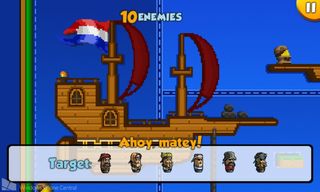
This version’s campaign is comprised mostly of standard death matches, though it does break things up a bit with destruction, boss, and football levels. Destruction turns the focus away from killing enemies and toward blowing up glowing objects. Bosses are giant, super tough opponents with a lot more firepower than standard enemies. The final boss, who took me 92 tries to beat on the console, went down in far fewer attempts here, thank goodness.
Get the Windows Central Newsletter
All the latest news, reviews, and guides for Windows and Xbox diehards.
Football levels are all getting the ball across the map and to the goal, constantly dodging enemies and without the ability to fire while holding the ball. I encountered a frustrating control bug in a few of these levels. Normally, after swiping in the desired direction, the player can hold his thumb in place and continue to move (just like holding an analog stick to move). This bug forced me to swipe repeatedly to move at all; it’s analogous to requiring someone to tape the stick for every single step their character takes instead of letting them hold it. Yet it didn’t happen every time I played a sports level, and it never occurred in the other, more common stages, so my enjoyment of the game wasn’t much diminished. The developers already patched the game to improve the controls once, but they may have a little farther to go.
Who needs legs when you’ve got rockets?
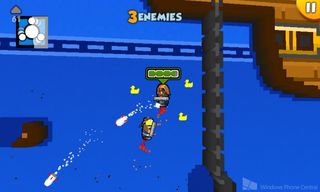
Rocket Riot comes to WP7 a distinctive and appealingly retro look. Its character designs resemble the Mighty Beanz toys, only here of course everyone’s got rockets attached to their bottoms. Like the toy line from which they draw inspiration, Rocket Riot’s characters are numerous and collectible. 100 unique hand-drawn characters become playable after they’re defeated, including pirates, robots, monsters, soldiers, and even the Code Glue development team.
Rocketcraft
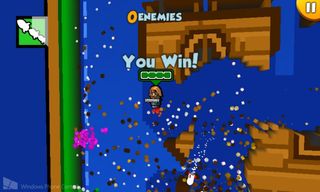
While the rocket-butted characters are 2-dimensional, the levels blend 2D and 3D in an interesting way. Code Glue basically took flat, pixelated 8-bit stage designs and turned everything into cubes. This gives the stages a slightly Minecraft-esque look. Everything is fully destructible, exploding into tiny blocks when shot. It’d be a shame to waste such a unique graphics engine on mundane stage design, but Rocket Riot doesn’t disappoint. Combat takes place on pirate ships, the moon, a rugby field, inside a computer, and other zany places.
Quiet, Rocket Riot!

Rocket Riot’s sound doesn’t charm quite as much as its visuals, though it does try. The lyrical theme song initially impresses, but wears thin due to repeating practically every other level. I thought I caught a line saying, “You’ve never had so much fun killing babies with your gun.” Fortunately the official website’s lyrics page proved me wrong: apparently I’ve never had so much fun killing meanies with my gun. I would have liked a greater variety of music, but that is a common complaint with phone games. It’s a shame that the hyperactive music variants that accompanied the miniaturizing power-up in the Xbox 360 game didn’t make the cut here. The sound effects are fairly standard. Enemies let out silly grunts and screams when they die, but more unique death screams would have differentiated them better.
Achievements: Hope for a hot spot
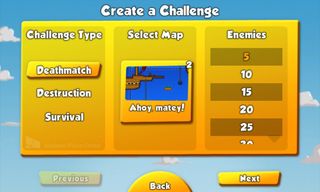
First off, Rocket Riot commits the heinous error of forcing players to be online in order to earn or view Achievements. Not cool. Mobile gaming is supposed to be just that, gaming on the go. Many people turn their phone’s data off while away from home; being locked out of earning Achievements won’t delight. Most WP7 Xbox Live games’ Achievements work offline or online… Too bad that’s not the case here.
Still, people generally have Wi-Fi at home, so Rocket Riot’s Achievements aren’t permanently out of reach. Most of them can be earned in a single campaign play through, but not all. Gamers will need to make another campaign run or spend some time with Quick Play in order to kill 5,000 enemies or destroy 1,000,000 blocks. Hunting these down should extend the life of the game.
Update: The Wi-Fi Achievement issue was eventually fixed with a patch.
Overall Impression
Rocket Riot stands out from other Windows Phone 7 games thanks to its excellent and natural controls, uniquely destructible environments, and whimsical retro graphics. It could use a little more content to make up for the lack of multiplayer that people expect from death-match shooters, but it's loads of fun while it lasts. Rocket Riot costs $4.99 on the Windows Phone Store - I recommend grabbing the free trial before deciding to blast off with it.
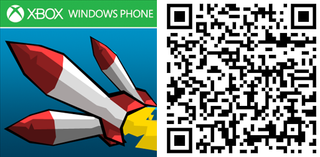
Paul Acevedo is the Games Editor at Windows Central. A lifelong gamer, he has written about videogames for over 15 years and reviewed over 350 games for our site. Follow him on Twitter @PaulRAcevedo. Don’t hate. Appreciate!
